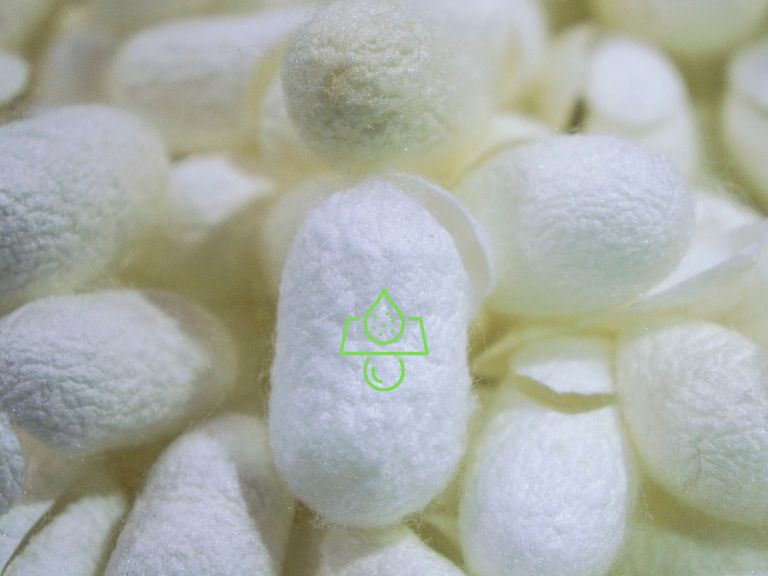Sericin has long been the subject of studies for its biological and functional properties. One of the most promising developments concerns its use in the environmental field, where it is proving to be a powerful natural biofilter, capable of adsorbing chemical pollutants and neutralizing pathogenic microorganisms, offering a sustainable response to the growing problems related to water pollution. This protein, in fact, can be processed to create bioactive membranes capable of retaining heavy metals and blocking the proliferation of bacteria, viruses and fungi in contaminated water. This approach, which combines biotechnology and natural materials, is at the center of a new frontier in environmental purification.
Bioactive membranes: how sericin transforms water
One of the most interesting applications of sericin in the environmental field is the creation of bioactive membranes for water treatment. Thanks to its molecular structure and the presence of functional groups such as hydroxyls, amines and carboxyls, sericin can be integrated into polymeric or natural supports to create surfaces capable of selectively interacting with organic and inorganic contaminants. These membranes, in addition to being biodegradable, show a strong chemical-physical affinity for toxic substances, behaving like true intelligent barriers. In laboratory and initial application tests, sericin-based membranes have demonstrated high stability, mechanical resistance and above all a marked ability to regenerate, a fundamental characteristic for sustainable and repeated use. Unlike traditional filters that often require aggressive chemical treatments to be reused, bioactive sericin membranes can be simply washed and treated with mild agents, keeping their performance unchanged.
Heavy metal capture: arsenic, lead and mercury
Heavy metals represent one of the main threats to human health and the environment, particularly in industrial areas and near mines, illegal dumps or intensively treated agricultural land. Arsenic, lead, mercury and cadmium are among the most widespread and dangerous contaminants, as they tend to accumulate in living tissues and cause neurological, hepatic and renal damage. Sericin has proven extremely effective in binding these metals, thanks to its rich composition of polar amino acids, which create electrostatic and coordination bonds with metal ions present in solution. The process occurs through the adhesion of contaminating particles to the protein surface, and can be enhanced through chemical functionalization techniques or combination with other natural materials such as cellulose and chitin.
The effectiveness of sericin in this context lies not only in its ability to capture metals, but also in its selectivity. Some studies have shown that, by slightly modifying the pH or membrane structure, it is possible to direct the absorption action towards specific elements, making the system adaptable to different needs. This makes sericin a strategic resource also for new environmental remediation technologies, which aim at targeted remediation of contaminated water and soil, minimizing the impact on useful microorganisms and reducing treatment costs.
Microbiological purification and pathogenic agents
In addition to removing chemical substances, sericin also possesses interesting antimicrobial properties, which make it an excellent candidate for microbiological water purification. Several experiments have demonstrated that sericin-based surfaces or gels inhibit the growth of bacteria such as Escherichia coli, Staphylococcus aureus, Pseudomonas aeruginosa and some fungal and viral strains. This action is due to a combination of effects: on one hand, sericin can interfere with the cell membrane of pathogens, compromising their stability and preventing their replication; on the other hand, it can act as a vector for bioactive substances, such as antimicrobial peptides or silver nanoparticles, amplifying their effectiveness.
The possibility of integrating these properties into a single filtering system – capable of retaining both chemical and biological agents – makes us understand that it is possible to have application prospects in wastewater treatment, non-potable water sources and even domestic purification systems. In a world increasingly threatened by cross-contamination and global health crises, having a natural, economical and multifunctional material like sericin available could represent a turning point for water security, especially in developing countries and post-disaster contexts.
A circular and sustainable future for silk biotechnology
The use of sericin as a biofilter is not only a technological frontier, but also a concrete opportunity to promote a more circular economy. This material, which until a few years ago was considered industrial waste in silk production, is today finding new valorization pathways in environmental and biomedical sectors. Its biodegradability, ease of extraction and compatibility with natural materials make it perfect for developing ecological, accessible and easily adaptable purification solutions for different territorial contexts.
Silk, in this new interpretation, is no longer just synonymous with luxury or beauty, but transforms into an active agent of ecological regeneration. Sericin, in particular, offers a virtuous example of how biotechnology can meet ecodesign to address concrete environmental challenges, restoring dignity and value to an ancient material through the logic of sustainable innovation.


